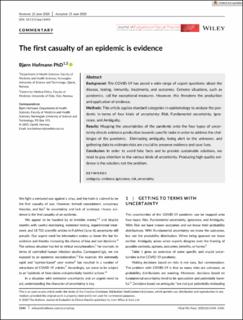| dc.contributor.author | Hofmann, Bjørn | |
| dc.date.accessioned | 2021-02-10T10:01:59Z | |
| dc.date.available | 2021-02-10T10:01:59Z | |
| dc.date.created | 2021-01-28T15:04:45Z | |
| dc.date.issued | 2020 | |
| dc.identifier.citation | Journal of Evaluation In Clinical Practice. 2020, 26 1344-1346. | en_US |
| dc.identifier.issn | 1356-1294 | |
| dc.identifier.uri | https://hdl.handle.net/11250/2727123 | |
| dc.description.abstract | Background
The COVID‐19 has posed a wide range of urgent questions: about the disease, testing, immunity, treatments, and outcomes. Extreme situations, such as pandemics, call for exceptional measures. However, this threatens the production and application of evidence.
Methods
This article applies standard categories in epistemology to analyse the pandemic in terms of four kinds of uncertainty: Risk, Fundamental uncertainty, Ignorance, and Ambiguity.
Results
Mapping the uncertainties of the pandemic onto the four types of uncertainty directs evidence production towards specific tasks in order to address the challenges of the pandemic: Eliminating ambiguity, being alert to the unknown, and gathering data to estimate risks are crucial to preserve evidence and save lives.
Conclusion
In order to avoid fake facts and to provide sustainable solutions, we need to pay attention to the various kinds of uncertainty. Producing high‐quality evidence is the solution, not the problem. | en_US |
| dc.language.iso | eng | en_US |
| dc.publisher | John Wiley & Sons | en_US |
| dc.rights | Navngivelse-Ikkekommersiell 4.0 Internasjonal | * |
| dc.rights.uri | http://creativecommons.org/licenses/by-nc/4.0/deed.no | * |
| dc.title | The first casualty of an epidemic is evidence | en_US |
| dc.type | Peer reviewed | en_US |
| dc.type | Journal article | en_US |
| dc.description.version | publishedVersion | en_US |
| dc.source.pagenumber | 1344-1346 | en_US |
| dc.source.volume | 26 | en_US |
| dc.source.journal | Journal of Evaluation In Clinical Practice | en_US |
| dc.identifier.doi | 10.1111/jep.13443 | |
| dc.identifier.cristin | 1881404 | |
| dc.description.localcode | This is an open access article under the terms of the Creative Commons Attribution‐NonCommercial License, which permits use, distribution and reproduction in any medium, provided the original work is properly cited and is not used for commercial purposes. | en_US |
| cristin.ispublished | true | |
| cristin.fulltext | postprint | |
| cristin.qualitycode | 1 | |

